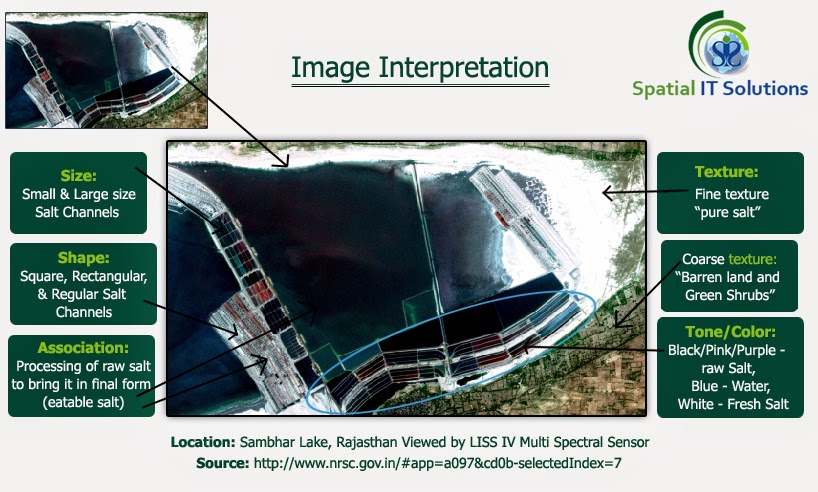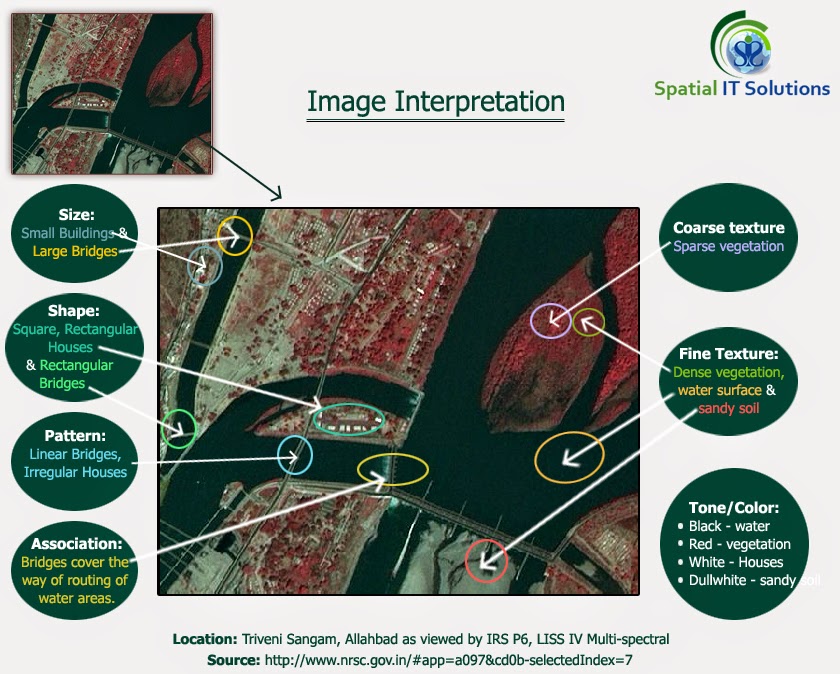Image interpretation is related with the identification of remote sensed objects or images and knowing about their significance. To see the useful result of image interpretation the primary tasks are:
- Detection
- Identification
- Measurement
- Problem solving
Detection- It is a primary task to detect or identify an object or feature.
Identification- When a particular target is identified or recognized, for example types of soil, vegetation, forest, rock etc.
Measurement- Measurement is related to the area, length, volume etc. of the targeted objects like forest, rock, water bodies etc.
Problem solving-Image interpretation also involves problem solving that means when an object or the feature is identified an analyst may also be asked to give the complex significances of an image which is sometimes not depicted and so the statement is given as a probability of correction.
The Attributes on which Interpretation is based are:
Identification- When a particular target is identified or recognized, for example types of soil, vegetation, forest, rock etc.
Measurement- Measurement is related to the area, length, volume etc. of the targeted objects like forest, rock, water bodies etc.
Problem solving-Image interpretation also involves problem solving that means when an object or the feature is identified an analyst may also be asked to give the complex significances of an image which is sometimes not depicted and so the statement is given as a probability of correction.
The Attributes on which Interpretation is based are:
- Location
- Size
- Shape
- Shadow
- Tone/colour
- Texture
- Pattern
- Height and depth
- Site/situation
- Association
1.Location- It is related with the position of the object that is global positioning of an object or feature.
2.Size- Size is one of the most important things to know as it tells about the length, breath and perimeter about the feature.It is important to know about the scale. Example sports fields.
3.Shape- The Shape also helps in image interpretation.There are numerous objects on the earth's surface with different shapes and features that helps to interpret.
4.Shadow- Shadow helps in identification of the objects like mountain, building, trees, etc. depending upon the low angle of the sun.
5.Tone/color- Tone refers to the shades of black, white and grey and color refers to the different combination of hue that is blue, green, red which is reflected from vegetation, water, soil etc. An interpreter can interpret through the specific reflected wavelength.
6.Texture- If the tone of different objects is uniform, then the texture helps to interpret the images through smoothness or coarseness.
7.Pattern- Pattern is related with the arrangement of objects, whether natural or man made on the land like settlement pattern, drainage pattern etc. For example some of the patterns are rectangular, triangular, linear, radial etc.
8.Height/depth- It is related with the elevation and is most helpful in detecting the images as it cast shadow depending upon the height and angle of the sun. Buildings and electric poles are the good examples as they are raised from the the ground.
9.Site/Situation/Association - Site here refers to the surroundings or the environment wheather natural or man made, for example regions like slope,hill, plateau, forest, soil etc. Whereas the situation refers to how these are arranged or situated in which manner. For example industries like steel plant industry. Assocition means the common features that is commonly associated with each other. Site, Situation and association mostly work together they are rarely independent. Example a large shopping mall is associated with number of buildings, parking lots, roads etc.


No comments:
Post a Comment